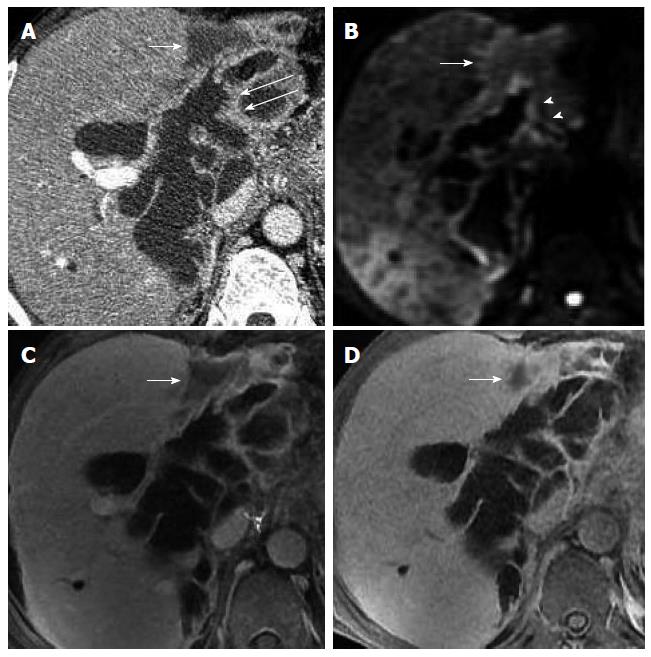Copyright
©The Author(s) 2015.
World J Gastroenterol. Jul 7, 2015; 21(25): 7824-7833
Published online Jul 7, 2015. doi: 10.3748/wjg.v21.i25.7824
Published online Jul 7, 2015. doi: 10.3748/wjg.v21.i25.7824
Figure 4 Sixty-six-year-old male patient with malignant intraductal papillary mucinous neoplasm of the bile duct (case 4).
A: Axial image of contrast-enhanced computed tomography in the portal venous phase showed a patchy hypointense area abutting the dilated bile ducts in the front edge of the left liver lobe (white arrow), and multiple small nodules distributed along the bile duct wall within the lumen (white long arrows); B: These nodules were hyperintense (white arrowheads) with diffusion-weighted imaging; C: Gadolinium-ethoxybenzyl-diethylenetriamine-pentaacetic acid-enhanced magnetic resonance imaging (Gd-EOB-DTPA-enhanced MRI) in the portal venous phase also showed a patchy hypointense area abutting the dilated bile ducts (white arrow); D: The patch (white arrow) appeared smaller with Gd-EOB-DTPA-enhanced MRI in the hepatobiliary phase, due to the gradual filling of contrast agent, which suggests the presence of functional liver cells. The patchy area was thought to be an inflammatory change secondary to the tumor.
- Citation: Ying SH, Teng XD, Wang ZM, Wang QD, Zhao YL, Chen F, Xiao WB. Gd-EOB-DTPA-enhanced magnetic resonance imaging for bile duct intraductal papillary mucinous neoplasms. World J Gastroenterol 2015; 21(25): 7824-7833
- URL: https://www.wjgnet.com/1007-9327/full/v21/i25/7824.htm
- DOI: https://dx.doi.org/10.3748/wjg.v21.i25.7824









